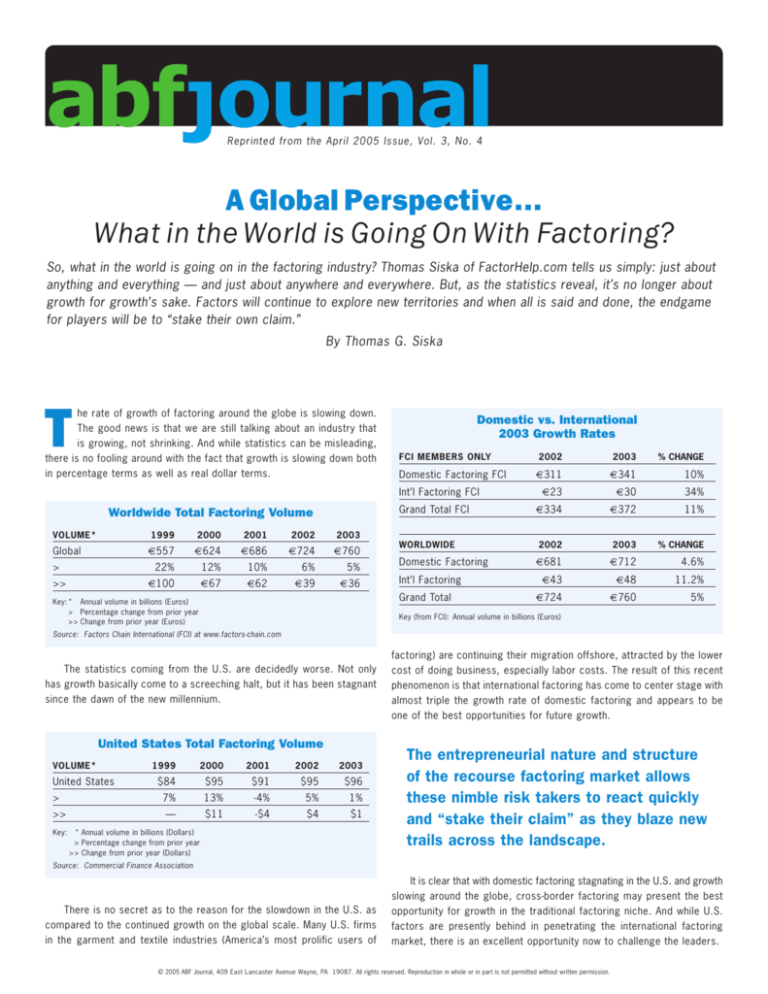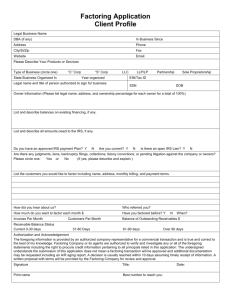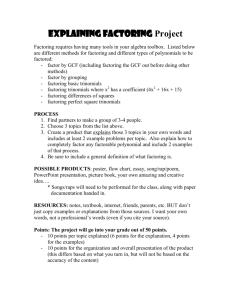
Reprinted from the April 2005 Issue, Vol. 3, No. 4
A Global Perspective…
What in the World is Going On With Factoring?
So, what in the world is going on in the factoring industry? Thomas Siska of FactorHelp.com tells us simply: just about
anything and everything — and just about anywhere and everywhere. But, as the statistics reveal, it’s no longer about
growth for growth’s sake. Factors will continue to explore new territories and when all is said and done, the endgame
for players will be to “stake their own claim.”
By Thomas G. Siska
he rate of growth of factoring around the globe is slowing down.
The good news is that we are still talking about an industry that
is growing, not shrinking. And while statistics can be misleading,
there is no fooling around with the fact that growth is slowing down both
in percentage terms as well as real dollar terms.
T
Domestic vs. International
2003 Growth Rates
FCI MEMBERS ONLY
Domestic Factoring FCI
Int’l Factoring FCI
Grand Total FCI
Worldwide Total Factoring Volume
VOLUME*
Global
>
>>
1999
2000
2001
2002
2003
€557
€624
€686
€724
€760
22%
12%
10%
6%
5%
€100
€67
€62
€39
€36
WORLDWIDE
Domestic Factoring
Int’l Factoring
Grand Total
Key: * Annual volume in billions (Euros)
> Percentage change from prior year
>> Change from prior year (Euros)
2002
2003
% CHANGE
€311
€341
10%
€23
€30
34%
€334
€372
11%
2002
2003
% CHANGE
€681
€712
4.6%
€43
€48
11.2%
€724
€760
5%
Key (from FCI): Annual volume in billions (Euros)
Source: Factors Chain International (FCI) at www.factors-chain.com
The statistics coming from the U.S. are decidedly worse. Not only
has growth basically come to a screeching halt, but it has been stagnant
since the dawn of the new millennium.
United States Total Factoring Volume
VOLUME*
United States
>
>>
Key:
1999
2000
2001
2002
2003
$84
$95
$91
$95
$96
7%
13%
-4%
5%
1%
—
$11
-$4
$4
$1
* Annual volume in billions (Dollars)
> Percentage change from prior year
>> Change from prior year (Dollars)
factoring) are continuing their migration offshore, attracted by the lower
cost of doing business, especially labor costs. The result of this recent
phenomenon is that international factoring has come to center stage with
almost triple the growth rate of domestic factoring and appears to be
one of the best opportunities for future growth.
The entrepreneurial nature and structure
of the recourse factoring market allows
these nimble risk takers to react quickly
and “stake their claim” as they blaze new
trails across the landscape.
Source: Commercial Finance Association
There is no secret as to the reason for the slowdown in the U.S. as
compared to the continued growth on the global scale. Many U.S. firms
in the garment and textile industries (America’s most prolific users of
It is clear that with domestic factoring stagnating in the U.S. and growth
slowing around the globe, cross-border factoring may present the best
opportunity for growth in the traditional factoring niche. And while U.S.
factors are presently behind in penetrating the international factoring
market, there is an excellent opportunity now to challenge the leaders.
© 2005 ABF Journal, 409 East Lancaster Avenue Wayne, PA 19087. All rights reserved. Reproduction in whole or in part is not permitted without written permission.
2003 Domestic Factoring Volume
RANK
# OF FACTORS
COUNTRY
1
110
United Kingdom
DOMESTIC
€158
2
45
Italy
€125
3
213
United States
€77
4
20
France
€68
5
15
Japan
€60
6
20
Spain
€36
7
18
Germany
€27
8
5
Netherlands
€16
2003 International Factoring Volume
RANK
# OF FACTORS
COUNTRY
1
45
Italy
INTERNATIONAL
€8.00
2
18
Germany
€7.95
3
20
France
€5.00
4
20
Taiwan
€4.30
5
213
United States
€3.20
6
110
United Kingdom
€2.50
7
4
Belgium
€2.00
8
9
Denmark
€2.00
Key (from FCI): Annual volume in billions (Euros)
At the end of 2004, U.S. import quotas for textiles expired. This will
surely change the landscape of this global industry since producers will
now relocate to the most advantageous areas. The movement already
started in late 2004 in anticipation of this industry-changing event. The
migration will involve the severing of established factoring relationships
in favor of firms more familiar with the manufacturer’s new country of
residence. The country that stands to be the biggest beneficiary of this
movement is, of course, China.
In addition to the many local Chinese and Hong Kong factoring divisions of banks, several familiar entities have already established their
presence in China, such as CIT, GE Commercial Finance (even though GE
sold its U.S. factoring operation to CIT) and UPS Capital. In turn, at least
one China-based factor already has a beachhead in the states, DBS Bank
Ltd. As evidenced in the previous charts, China (together with Hong Kong)
does not rank in the top eight in factoring volume for either domestic or
international factoring. As such, it is fertile territory waiting to be harvested.
The one ray of hope in the domestic U.S. traditional factoring market
is the recent success some of the established players have shown in taking
their core competency, retail credit and collection services, to industries
outside of garment and textiles. CIT has established a position in the
seafood industry while most every traditional factor has made a push into
electronics, housewares and toys. It is expected that these factors will
continue to attack any and every product category coming out of retail.
Another clear and continuing trend can be summed up in three words:
consolidation, consolidation and consolidation. Within the last two years,
CIT accomplished its version of “addition by subtraction” by purchasing
the seventh and fifth largest competitors by volume at the time, GE
Commercial Services and HSBC’s factoring unit. GMAC, SunTrust and Wells
Fargo Century (second, third and fourth, respectively) can’t be too far
behind in making moves of their own. And while it’s “out with the old,”
there was actually a new entrant, First Capital Corporation, which began
its foray into non-recourse factoring.
The net effect was another decline in the number of individual players
competing in this space, resulting in a reduction of people employed as
well. The offset to the drop in traditionally trained personnel is the hiring
of people in the international departments, those with knowledge of nontraditional industry niches and ABL trained credit executives to manage
the inventory exposures that are growing due to competitive deal structuring. The long-term employment effect of these initiatives won’t be known
until sometime in the future when it can be determined if the players can
truly succeed in these new areas.
Non-Traditional, Recourse Factoring
There has been very little attention paid to cross-border transactions
by the recourse factors in the U.S. While the number of recourse factors
is estimated to be above 1,000, the number of these factors that focus
on international transactions is less than a dozen. Even these tend to work
in concert with either an independent credit insurance company or the
Export-Import Bank of the U.S. Both of these insurance sources cater to
a more balance-sheet oriented borrower, eliminating the lion’s share of
clients the recourse factors target. So it is doubtful that recourse factors,
as a whole, will make a global push any time soon. However, 2005 and
beyond should find several recourse factors carving out a niche in not
only cross-border trade, but in just about every other facet of trade receivables known to man. The entrepreneurial nature and structure of the
recourse factoring market allows these nimble risk takers to react quickly
and “stake their claim” as they blaze new trails across the landscape.
Even the largest and most institutional of recourse factors, Wells Fargo,
is quietly making a market with its factoring product that didn’t exist just
five years ago. The largest of recourse factoring clients used to have
maybe $25 million in annual sales. A few clients may have been as large
as $50 million in sales. Incredibly, Wells Fargo has funded a couple of
clients with factored volume exceeding $250 million annually. With a low
cost of funds, Wells finds its recourse factoring product to be, in certain
cases, a more efficient substitute for receivable securitizations.
There are now factors that fund sales commissions (mostly postcontract fees of real estate brokers). A few will pre-fund retail sales (such
as advancing one week’s worth of receipts to a restaurant). Many more
will now provide leasing, inventory advances, purchase order financing
or other such accommodations to secure the “bread & butter” factoring
business. Several are venturing into the construction industry. Medical
receivable factors, both entrepreneurial as well as large institutional firms,
are popping up everywhere. Similarly, both institutional and independent
factors specializing in a single industry continue to thrive in transportation and staffing. The staffing niche is so saturated there are now factors
that will advance on permanent placement fees (one firm only factors
permanent placement). Another new entrant specializes in the slow pay,
contingent fee area of advertising agency paper.
An even more interesting development in recourse factoring is the
targeting of a particular sales channel, as opposed to a particular client
industry. There is a factor that specializes in its ability to work through
CPAs. Several specifically target banks. Another is trying to own the DIP
attorney referral space.
As mentioned earlier in this article, even traditional factors are once
again looking at the recourse market as a way to leverage its existing
sales channel. So it is safe to say that where there is a slight hole in the
marketplace, someone will no doubt step in and try to fill it. And while
filling a need is good, “owning” a piece of the market is much better.
Lastly, banks continue to push forward with recourse factoring variations. From the largest of banks, such as Wells, to small independent
community banks, factoring remains a popular product. Even though quite
a few banks have been exiting the space recently, that number is still
© 2005 ABF Journal, 409 East Lancaster Avenue Wayne, PA 19087. All rights reserved. Reproduction in whole or in part is not permitted without written permission.
more than offset by the banks jumping in. Further, if history is a guide,
the restrictions that the federal government just lifted on credit unions
is an invitation to a whole new wave of competitors. When the same thing
happened to the savings and loan industry in the 1980s, the S&Ls moved
into factoring faster than any bank did. While credit unions probably won’t
move quite as fast as their S&L predecessors, they are sure to make a
splash in the future.
Conclusion
So what in the world is going on in the factoring business? Well, just
about anything and everything. And just about anywhere and everywhere.
Expect to see almost every traditional factor spreading out beyond its
core industry segments and beyond the border in its established niches,
thus creating growth for the firm and overall employment. And what is
good for the goose will be good for the gander. In other words, we’ll see
foreign factors coming to the U.S. (such as the already established factor
from the UK, Bibby Financial). Recourse factors will be doing bigger deals
(it is now fairly routine to fund outstanding receivable balances between
$2 million and $5 million through newly created participation arrangements) and smaller deals (there is one factor that has amassed $2 million
in A/R in less than 18 months with the average client below $10,000 in
monthly volume). They will broaden their product offering and venture into
uncharted industry segments. Overall employment should continue to grow
at a fairly robust pace. And the name of the game is no longer to grow
for growth’s sake. Factors will pick something they can establish a presence in and push to own their space. These pioneers will no longer accept
simply blazing the trail. They’ll continue to explore, but the endgame will
be to stake their claim. Happy trails in 2005!
Thomas G. Siska is managing director for FactorHelp.com, a consulting,
service provider and distributor to the factoring and small ABL industries. He
is also president and co-founder of the National Funding Association’s
Chicago chapter. Siska’s experience includes senior vice president and Western
region manager for the small business factoring and ABL unit of GE
Capital. Prior to that, he led the turnaround and ultimate sale of Concord
Growth Corporation to Bay View Bank in San Mateo, CA (now Bay View
Funding). He began his career in finance when he opened the Chicago branch
office for a nationwide small ABL and factor in 1984 and later their
Canadian branch in 1987. Siska reports out of Chicago and can be reached
at 847-498-9136 or TSiska@FactorHelp.com.
© 2005 ABF Journal, 409 East Lancaster Avenue Wayne, PA 19087. All rights reserved. Reproduction in whole or in part is not permitted without written permission.










